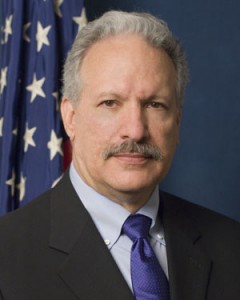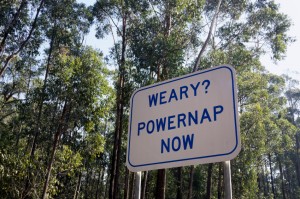
March 1, 2014 | Posted in Drowsy Driving, Podcast Episodes | By Traffic Safety Guy
Comments Off on 14 – Drowsy Driving: Take the Time to Sleep
Podcast: Play in new window | Download
Subscribe: RSS
“Anyone who is human and gets behind the wheel [of a car] should worry about it.” NTSB Board Member Mark Rosekind speaking on drowsy driving.
“There will be sleep enough in the grave.” How many times have we heard someone say something similar, implying that he or she doesn’t need or have time for sleep? Ben Franklin made that statement over 200 years ago and it is still used today, sometimes as a badge of honor. In today’s culture, with many of us traveling in large and potentially deadly weapons on a road or highway, mixing the lack of sleep with driving is a deadly combination. However, there are practical steps each of us can take to avoid these dangers, with acknowledgement of the existence of drowsy driving being the first.
Dr. Mark Rosekind, Board Member of the National Transportation Safety Board (NTSB) and one of the world’s foremost human fatigue experts, examines the fallacy that we can put sleep off to a later time. As human beings, we are hardwired for sleep. We have to breath, we have to eat, we have to drink, and we have to sleep. It is a biological requirement for our survival. Starting with that premise, Dr. Rosekind discusses:
- How much sleep we need
- What happens when we don’t get a sufficient amount of sleep
- How fatigue plays a role in drowsy driving, and
- What we can do about driving and fatigue
Having a “Sleep Debt”
As we age the amount of sleep needed each night changes. What many people do not understand is that teens actually need 9¼ hours of sleep, not the typical 8 hours mentioned. What is especially concerning is that in high school teenagers get on average 6½ hours of sleep. They may think that they are 90 minutes short on sleep, but they are actually more than two hours below what is needed. Adults need 7-9 hours or an average of 8 hours. This is true as we age and become senior citizens, although in our later years our sleep patterns are broken up. We still need the 8 hour average, however, it is not as refreshing thus it is often harder to get a good night’s sleep. Many retirees enjoy a mid-day nap to help make up for the lost overnight sleep. This is why teens and senior citizens are considered higher risks for drowsy driving.
When we don’t get sufficient sleep, we start to build up a “sleep debt.” One night of poor sleep, and our abilities are affected. If we don’t get sufficient sleep a second night, the sleep debt increases. Go a third night, and it continues to accumulate. Go three nights with 2 hours lack of sleep each night, and the sleep debt is up to 6 hours. In a single night, losing 2 hours of sleep can result in a person acting as if they were at a .05 BrAC (Breath Alcohol Content).[1] With a sleep debt, our attention, reaction time and decision making are all significantly effected by as much as 20-50%. A slower reaction time or making a poor decision means not reacting to the brake lights in front of us or seeing the traffic light turning red. Falling asleep while driving can have devastating consequences.
Drowsy Driving’s Impact is Underestimated
How dangerous is drowsy driving? There are estimates in the U.S. that annually we could be looking at a million or more crashes or near crashes – 20% of all crashes could be due to fatigue. All the experts agree that the number of crashes and fatalities due to fatigue is underestimated.
According to the Automobile Association of America (AAA) two out of every five drivers (41.0%) reported having fallen asleep or nodding off while driving, and that one in four reported that they had fallen asleep between the hours of noon and 5 p.m. Drowsy driving happens during the night and during the day.
Drowsy driving is a problem no matter where we live or travel. Last year in India, a bus crashed, killing 45 people. One media outlet reported that the driver admitting he dozed off while driving. Pick any country, and you can find reports of drowsy driving.
Possible Solutions to Drowsy Driving?
Many of us, when we notice we are sleepy while driving, try to “fix” it by turning up the radio or opening the window, or biting a lip. These “remedies” work for only about 10 minutes. Caffeine can provide a short-term jolt, but even that is limited in time and needs to be taken before feeling tired since it requires time for us to feel the effects. Bottom line: We are still sleep deprived and we are still dangerous as we drive down the road.
The only real solution to drowsy driving is sleep, whether it is finding a safe place to stop and get a short nap, such as at a Rest Area or a good night’s sleep before leaving.
3-Step Checklist Before Traveling
To be prepared for any drive, Dr. Rosekind provides a three-step checklist:
- Recognize that fatigue is a risk and ask:
- Do you have a sleep debt from the last night or a combination of nights?
- How long have you been awake at this point?
- What is the time of day when the driving is occurring?
- Do you have a sleep disorder?
- If fatigue is an issue, take a nap or get some caffeine.
- Be sensitive to the environment. Are you driving at night or on a monotonous road? Driving in these conditions can reveal your fatigue.
Individually, each of these steps can raise a red flag. Combined, they ensure we consider what condition we are in, and whether we are safe to travel. Reviewing this checklist can save lives. In the meantime, get a good night’s sleep.
Related Links:
Websites:
- Automobile Association of America (AAA) – Drowsy Driving
- Drowsy Driving.org
- National Sleep Foundation (NSF) – Drowsy Driving
- NTSB
Research:
- AAA Report on Drowsy Driving
- National Highway Traffic Safety Administration (NHTSA) Research on Drowsy Driving
- NSF White Paper on Drowsy Driving
Other:
- Bus Crashes in India Result of Drowsy Driving
- Highway to Safety Podcast Episode #1 – Impaired Driving
[1] .08 BrAC is the level when a person is presumed to be under the influence of alcohol in the United States and some countries. A majority of countries have .05 BrAC or lower as the illegal limit.




